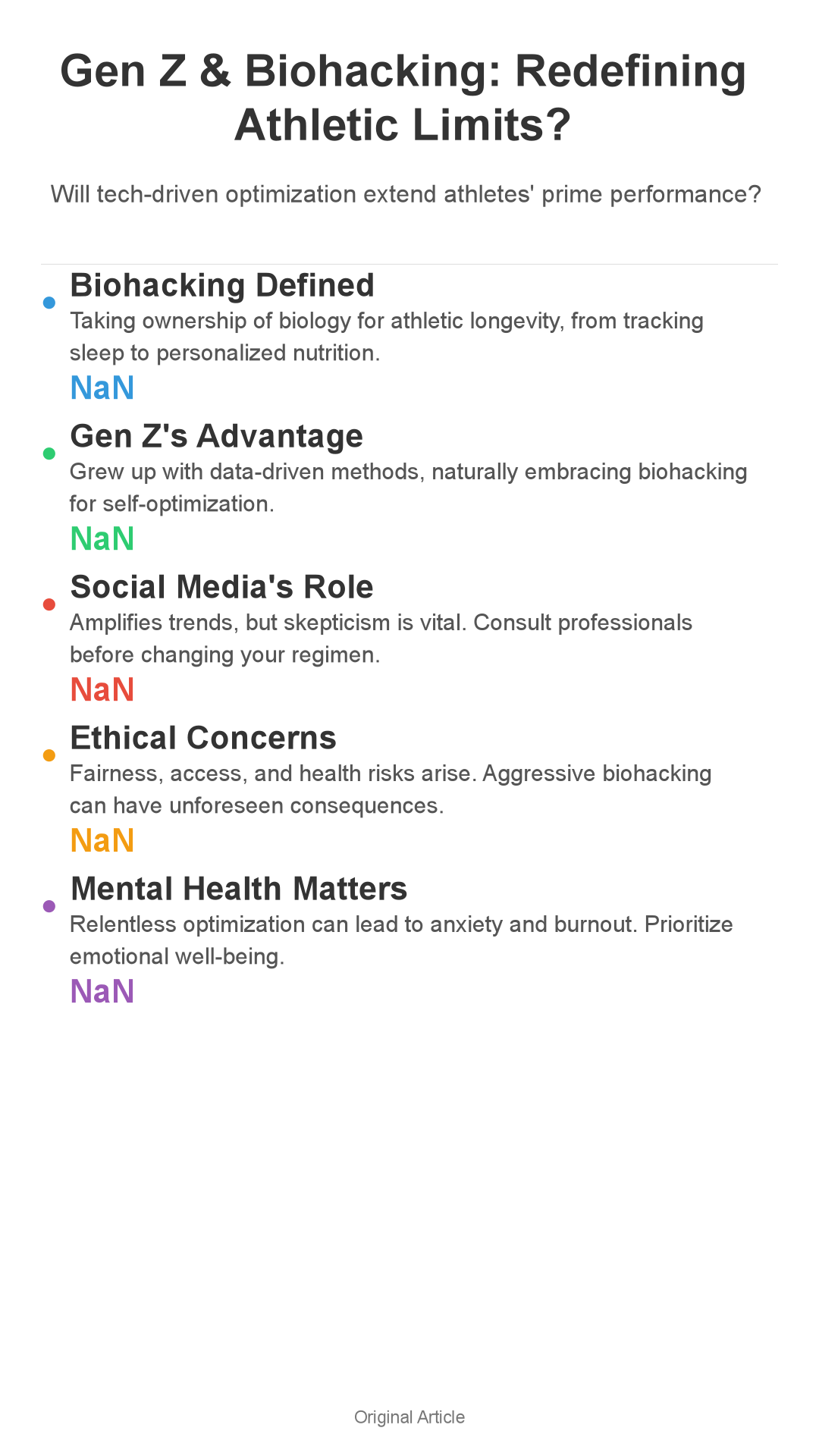
Gen Z's relentless pursuit of peak fitness is colliding with the biological realities of aging and m
Forget the mythical fountain of youth! Are Gen Z fitness fanatics poised to biohack their way to extended athletic careers and delayed motherhood, or are they chasing an unattainable ideal? Smash that like button if you’re ready to explore this fascinating, and potentially risky, trend. Follow us for more fascinating dives into future tech and cultural shifts!
We’re rapidly approaching an era where the boundaries between biology and technology are blurring, a phenomenon strikingly evident in the world of elite athletics.
Gen Z, the digital generation, is leading the charge, equipped with wearables, data analytics, and an unwavering commitment to self-optimization. But will they truly rewrite the rules of aging and athletic performance through biohacking?
The Rise of Biohacking and Personalized Optimization in Gen Z Fitness Culture
Defining “Biohacking” in the Athletic Arena
At its core, biohacking is about taking ownership of your own biology. In the context of athletic performance and longevity, this spans a spectrum of practices.
On one end, we see relatively harmless approaches like meticulous sleep and nutrition tracking using wearables.
On the other, there are more controversial interventions, such as specialized supplement regimens, gene editing (CRISPR is a prominent example, but its ethical implications are HUGE), and hyper-personalized nutrition plans based on individual genetic profiles.
Gen Z: Data Natives Embracing Biohacking
Gen Z has grown up with technology seamlessly woven into their daily lives. They’re comfortable collecting data, interpreting trends, and using apps to fine-tune everything from sleep patterns to macronutrient ratios.
This inherent familiarity with data-driven methods makes them ideal candidates for embracing biohacking.
Just a quick scroll through TikTok or Instagram reveals countless influencers promoting the supposed benefits of everything from ice baths and red light therapy to nootropics and customized vitamin protocols.
Social Media: Amplifier and Misinformation Source
Social media plays a significant role in amplifying biohacking trends. Influencers share their personal experiences, often showcasing dramatic results and attracting large followings.
While some offer valuable insights and promote evidence-based practices, others spread misinformation and promote potentially dangerous products or techniques.
It’s essential to approach these trends with healthy skepticism and consult qualified healthcare professionals before making any significant changes to your health or fitness regimen.
Extending the Athletic Prime: Is it Ethically Sound and Practically Achievable?
The Science of Delaying Athletic Decline
The aspiration to extend the athletic prime is powerful, and science is offering some intriguing possibilities.
Carefully managed hormonal optimization (for example, testosterone or estrogen levels), injury prevention strategies (such as targeted strength training and advanced recovery methods), and personalized nutrition all contribute.
Emerging biohacks include peptides for accelerated healing, sophisticated sleep optimization protocols, and even experimental therapies targeting cellular senescence (the aging process itself).
Ethical Considerations: Fairness, Access, and Health Risks
The pursuit of extended athletic performance through biohacking raises profound ethical questions. Is it fair to allow athletes to employ advanced technologies to gain an advantage over their competitors?
Will access to these technologies create a disparity between the “haves” and “have-nots” in the athletic arena? And what about the potential health risks?
Aggressive biohacking can lead to unforeseen consequences, including hormonal imbalances, organ damage, and even mental health challenges.
Long-Term Consequences: Mental Health and Overall Well-being
The intense pressure to perform at peak levels for extended periods can significantly impact an athlete’s mental health. The relentless pursuit of optimization can lead to anxiety, burnout, and a distorted sense of self-worth.
It’s crucial to remember that athletic performance is just one facet of overall well-being. Athletes must prioritize their mental and emotional health alongside their physical performance.
Delayed Motherhood: Societal Pressures and Biohacking Solutions
The Trend of Delayed Motherhood Among Female Athletes
Delayed motherhood is an increasingly prevalent trend among female athletes.
This is driven by several factors, including the demands of their careers, the desire for financial security, and societal expectations to achieve certain milestones before starting a family.
Biohacking Options for Fertility and Reproductive Lifespan
Biohacking offers potential solutions for women seeking to delay motherhood. Egg freezing has gained popularity, allowing women to preserve their fertility for future use.
Hormonal therapies, such as those used in IVF, can also be employed to improve fertility. Lifestyle interventions, like optimizing nutrition and managing stress, can also play a role.
Risks and Limitations: Informed Decision-Making is Key
Using biohacking to circumvent the biological realities of aging and fertility is not without its downsides. Egg freezing, for instance, is an invasive procedure with potential side effects.
Hormonal therapies can also pose significant health risks. It’s imperative that women are fully informed about the risks and limitations of these technologies before making any decisions.
They should also consult with qualified healthcare professionals to determine if these options are appropriate for them. Ultimately, informed consent and realistic expectations are paramount.
The Future of Fitness and Reproduction: A Gen Z Perspective
Changing Attitudes: Control and Technology
Gen Z holds different views on aging, athleticism, and parenthood compared to previous generations. They are more inclined to embrace technology and believe they can control their own destinies.
Exacerbating Inequalities: Access to Healthcare
The growing accessibility of biohacking technologies could worsen existing inequalities in access to healthcare and reproductive technologies.
Wealthier individuals will have greater access to these technologies, potentially creating a divide between those who can afford to optimize their bodies and those who cannot.
Promoting Realistic Expectations and Holistic Well-being
It’s crucial to promote realistic expectations and a holistic approach to health and well-being. While biohacking can offer certain advantages, it’s not a panacea.
It’s important to prioritize overall health and well-being over the relentless pursuit of optimization. This includes focusing on mental health, stress management, and healthy relationships.
So, what are your thoughts? Is biohacking the future of athletic performance and reproductive health, or are we setting ourselves up for disappointment and potential harm? Share your opinions in the comments below!
Want to stay informed and explore more thought-provoking topics? Subscribe to our newsletter for exclusive content and insider insights!
Conclusion
Gen Z athletes are increasingly turning to biohacking to extend their athletic primes and potentially delay motherhood.
While these technologies offer some exciting possibilities, they also raise ethical questions and highlight the need for informed decision-making.
Takeaway
As biohacking becomes more accessible, how do we ensure that it’s used responsibly and ethically, prioritizing overall well-being over the relentless pursuit of optimization?

Enjoyed this? Check out our YouTube channel for video versions!
Enjoyed this? Check out our YouTube channel for video versions!



